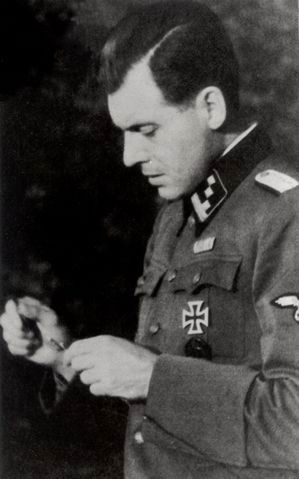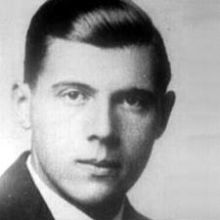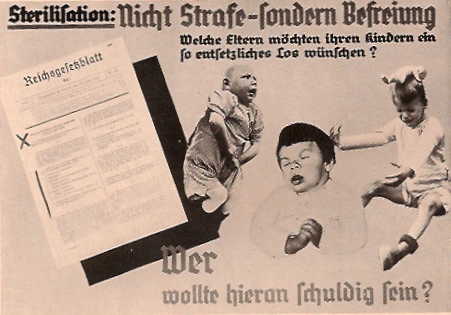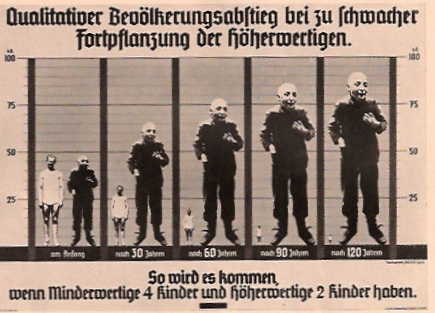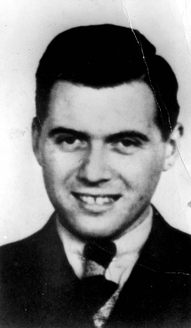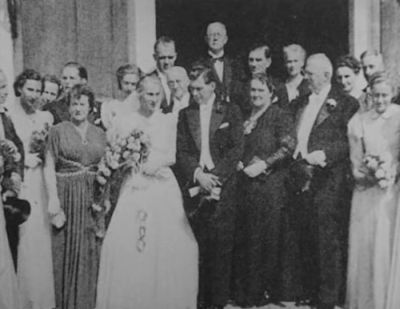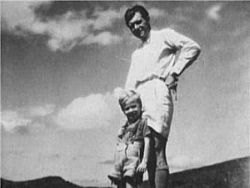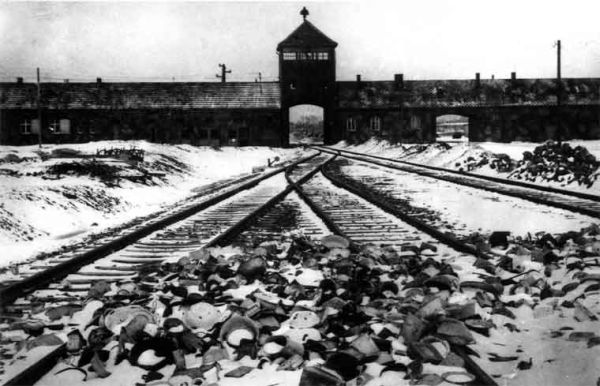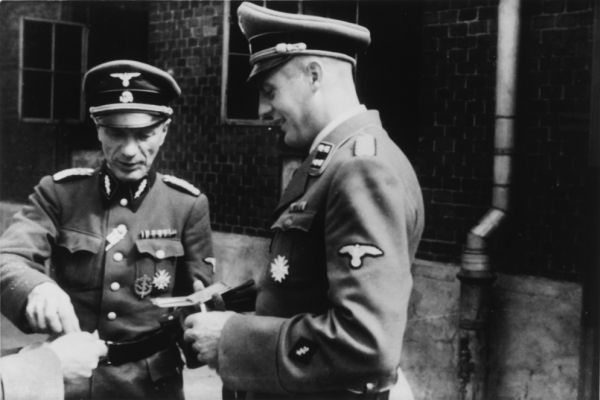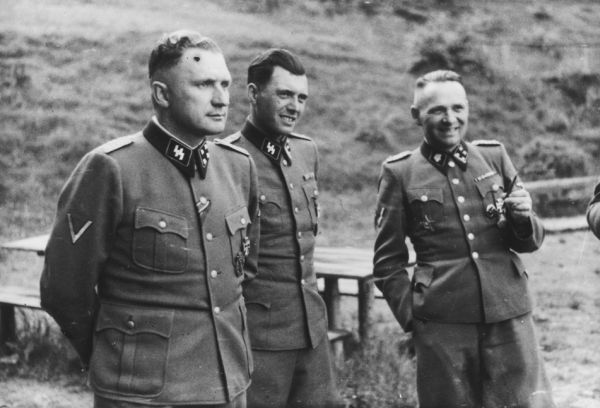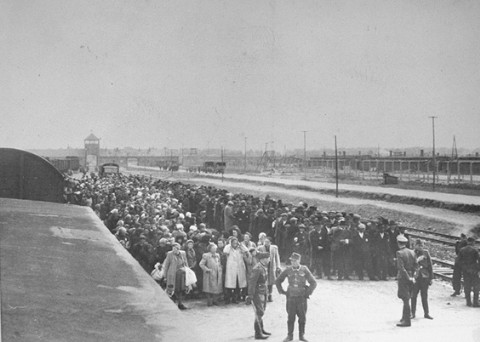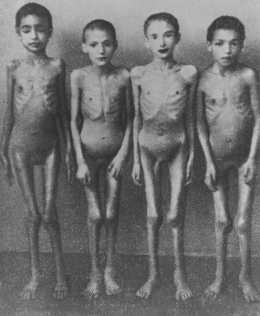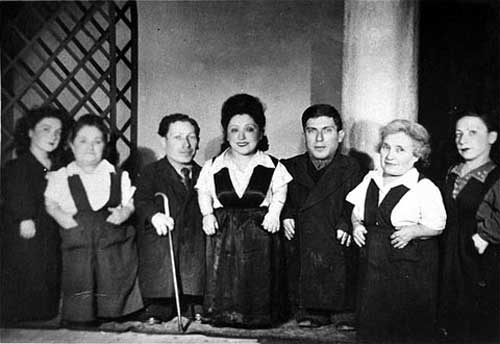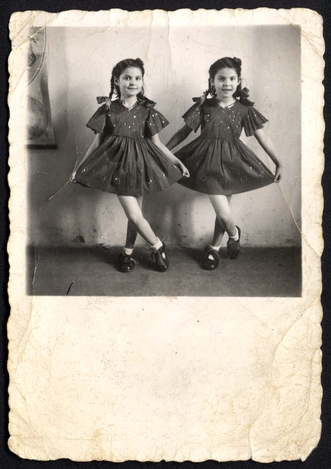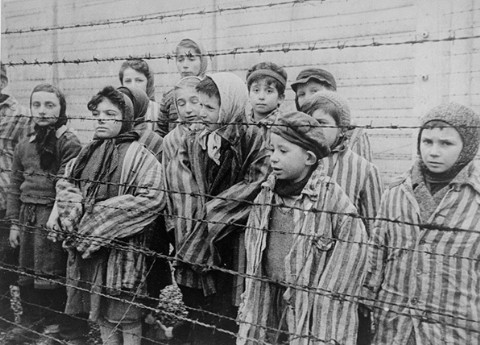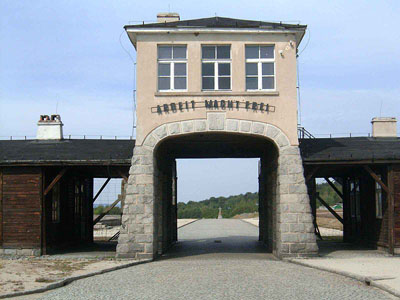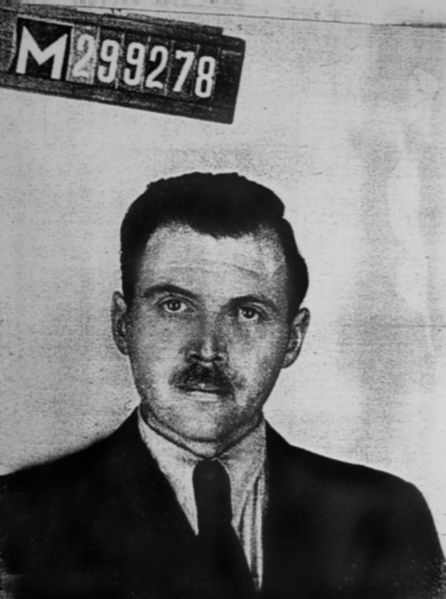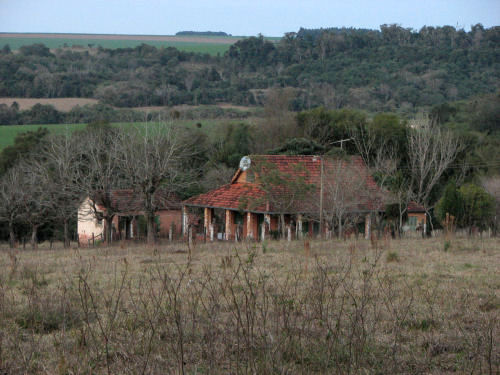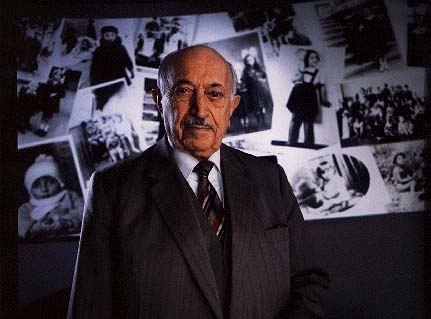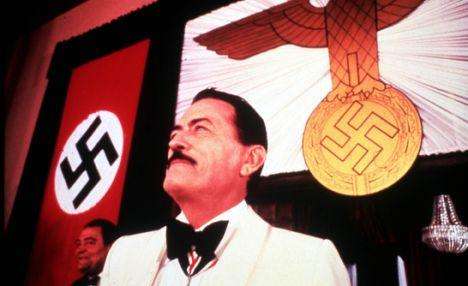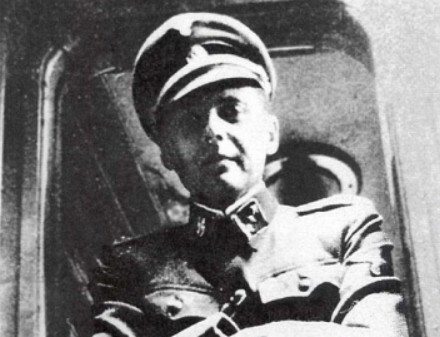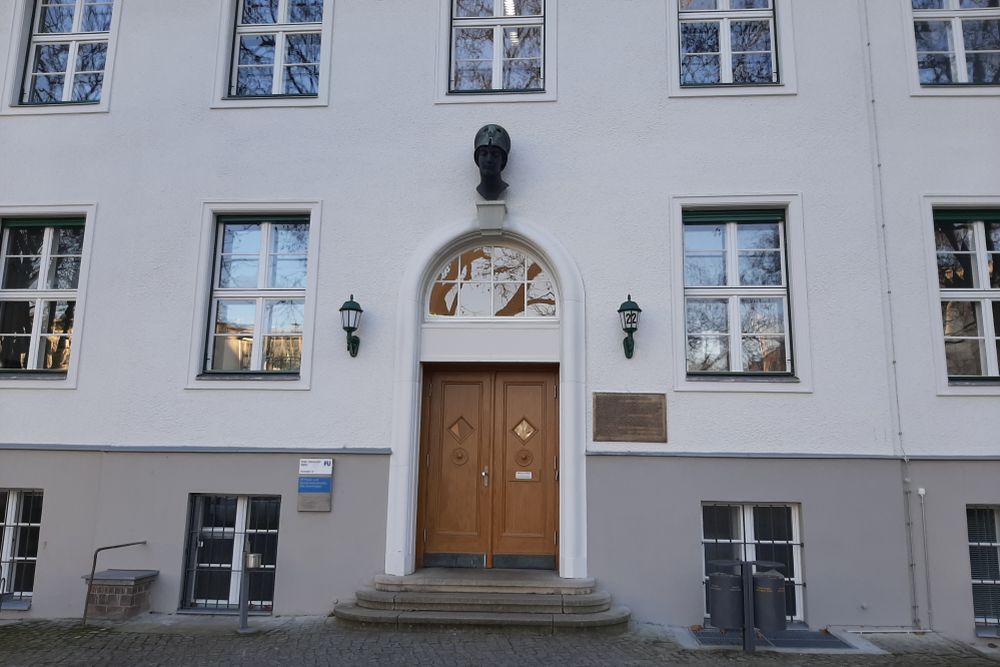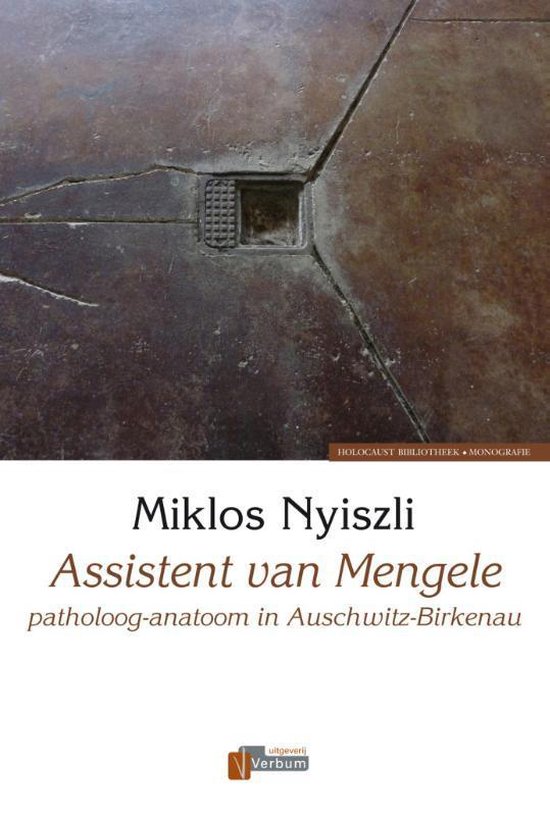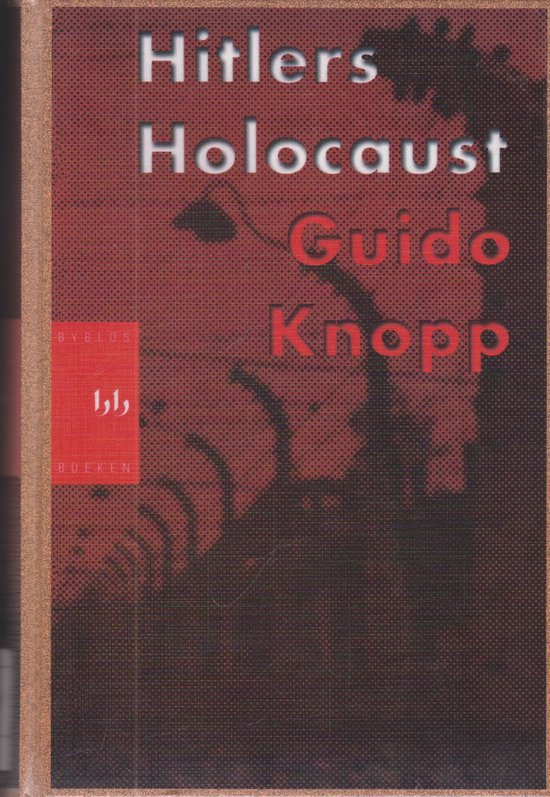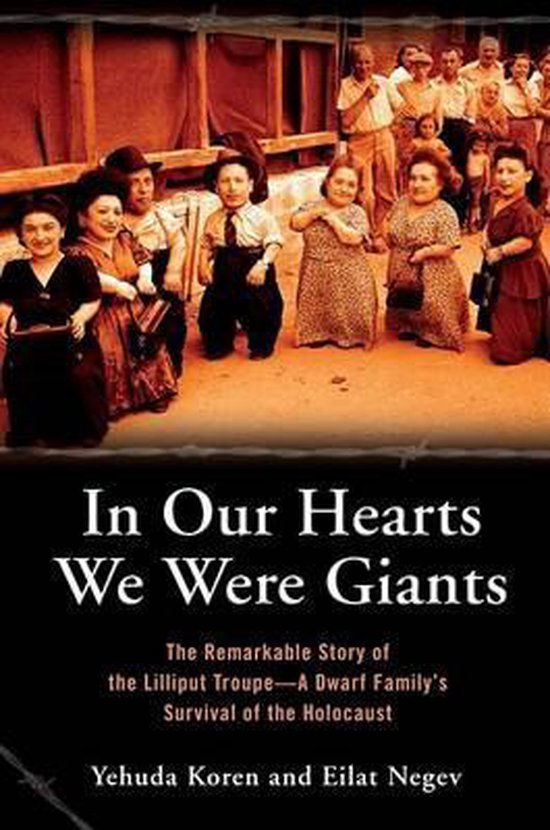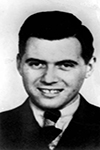Introduction
Joseph Mengele (1911-1979) became notorious by the crimes he committed as a physician in concentration camp Auschwitz. He conducted ghastly medical experiments on inmates and during selections on the platfom of Auschwitz-Birkenau, he sent numerous Jews and Gypsies to the gas chambers. He paid special attention to twins and to people with a conspicuous physical abnormality such as dwarfism. With his research, he aimed to make a contribution to the nationalsocialist racial ideology that assumed superiority of the Arian race and the inferiority of groups of the population such as Jews and Gypsies.
In the 30s, Mengele studied medicine and anthropology. In the course of time, he was introduced to eugenetics, the science aimed at improving the race. The notion that one race was superior to the other and that the physically and mentally disabled posed a threat to the well being of the race, did not originate from Hitler’s mind but was common knowledge within the scientific community in Nazi Germany. During his lessons in racial science, the foundation was laid for the crimes Mengele would later committ in Auschwitz.
Prior to Mengele being posted in Auschwitz in the spring of 1943, he served as an SS physician on the Eastern front. The camp doctor who would be feared so much later on, returned a highly decorated war veteran who had risked his life for others. It was in Auschwitz where he abandoned medical ethics and took lives instead of saving them. In this, he was not alone though, as in Auschwitz as well as in other concentration camps and elsewhere, German physicians conducted experiments on inmates during the war, contributing to the mass murder of the disabled, Gypsies and Jews.
Much more than any other Nazi doctor, Mengele became the symbol of perversity of the medical science in Nazi Germany. Nicknamed the Doctor of Death, he typified the cruel camp doctor who conducted all kinds of bizarre experiments on inmates. His notoriety only increased as he managed to remain hidden in South-America for more than 30 years and was never tracked down during his lifetime. Nazi hunter Simon Wiesenthal kept surprising the world with new "facts" on Mengele’s whereabouts, even when the Nazi doctor had long since passed away without having stood trial for his crimes.
Definitielijst
- Auschwitz-Birkenau
- The largest German concentration camp, located in Poland. Liberated on 26 January 1945. An estimated 1,1 million people, mainly Jews, perished here mainly in the gas chambers.
- concentration camp
- Closed camp where people are being held captive that are considered to be anti- social, enemies of the state, criminal or unwanted individuals. These groups mostly do not get a fair trial or are condemned to doing time in a camp.
- ideology
- A collection of principles and ideas of a certain system.
- Jews
- Middle Eastern people with own religion that lived in Palestine. They distinguished themselves by their strong monotheism and the strict observance of the Law and tradition. During World War 2 the Jewish people were ruthlessly persecuted and annihilated by the German Nazis. . An estimated 6,000,000 Jews were exterminated.
- Nazi
- Abbreviation of a national socialist.
Images
Childhood and study
Joseph Mengele was born 16 March 1911 in Günzburg, Bavaria. His father, Karl Mengele (1884-1959) descended from a family of farmers and had graduated in mechanical engineering. With capital of his mother, an independent hat manufacturer, Karl managed to establish an agricultural machinery plant. The succesful enterprise became known as Karl Mengele & Söhne and was one of the most important manufacturers of agricultural equipment in Germany up to the 90s of the previous century. With his wife Walburga Hupfauer, stemming from a wealthy family, Karl Mengele had three children. Joseph was the eldest, followed by Karl jr. (1912) and Alois (1914). The children were raised in Catholic fashion and served as altar boys in the Frauenkirche in their hometown of Günzburg.
The Mengele family was Catholic-conservative, German nationalistic and offered the children a stable environment. In the years of economic and social crisis following the First World War, in which father Mengele served, the familiy managed to sustain itself well. The factory of agricultural machinery provided them with financial security. As a result of the relative sound position of his parents, Joseph did lead a rather isolated life as compared to his contempories whose situation at home was less prosperous. In 1921 he attended the gymnasium. Just like at home, at school a nationalistic and conservative morale prevailed. Quite a number of teachers were veterans of the war and member of the paramilitary veterans association Stahlhelm-Bund der Frontsoldaten. It is likely that the foundation for Mengele’s future political ideas was laid at school. Outside the school, these ideas were developed further. At the age of 12, Joseph enlisted in the right wing-conservative paramilitary youth organisation Gross Deutscher Jugendbund (G.D.J.). He was to retain his membership until 1930 and was named Ältestenführer of the branch Günzburg in 1927.
A future scientific career for Mengele did not yet seem likely at the gymnasium. In 1930, at the age of 19, he passed his final exams with mixed results. His knowledge of German, Latin, Greek and mathematics was considered inadequate. In contrast, he did achieve marks like cum laude and most satisfying on subjects as religion, physics, English, history and geography. After graduation, Joseph left home to study medicine in Munich. Not he, but his youngest brother would later succeed his father as owner of the company. Joseph felt homesick but his ambitions were stronger. He wanted to prove he was capable of extraordinary achievements, an ambition that would also typify him later in Auschwitz. As a student in Munich, Mengele behaved himself inconspicuously but he remained a lone wolf more or less. He did take part in social activities more often though but a fellow student described his attitude as cool, aloof and arrogant.
In 1931, Mengele continued his studies in Bonn. After having witnessed a Communist demonstration in town, his political interest was roused. He allegedly would have fought the "Bolshewistic evil" and joined the Jungstahlhelm (youth organisation of Stahlhelm) in 1932. At university he achieved good results and socially he also adapted well. He interrupted his studies in Bonn, where he passed his first exam as a physician in the summer of 1932, to take up a semester in medicine in Vienna. From the summer of 1933 onwards, he continued his studies in Munich, the birthplace of National socialism. He studied anthropology as a subsidiary subject at the faculty of philosophy. After the seizure of power by the Nazis in 1933, he was automatically incorporated in the Sturmabteiling (SA), being a member of Stahlhelm. His membership would not last long as he resigned in October 1934. He claimed reasons of health but it is likely that the real reason had been the downfall of the SA following the Night of the Long Knives. The organisation had no future anymore, especially not for an ambitious young man like Joseph Mengele.
As a student in medicine and anthropology, Mengele fared much better than as a pupil of a gymnasium. He was a fine student with a gift for science. He displayed a special interest in genetics and physical anthropology. His curriculum included the much debated subject of the time: racial purity. In his final year at university, he attended classes of the racial theoretician and psychiatrist professor Ernst Rüdin who stood at the roots of the National socialist racial ideology. The latter was one of the authors of the 1933 Nazi law which permitted the mentally ill and those suffering from a congenital physical handicap to be sterilised involuntarily, preventing them from having offspring (which would weaken the Germanic race). The notions that one race was superior to the other and that the disabled would weaken the race, formed the foundation for the crimes the Nazis would later committ in Auschwitz and elsewhere and in which Mengele himself would also take part. During his study he could not yet envisage to what crimes this notion would lead.
Definitielijst
- First World War
- Took place from 1914 till 1918 and is also named The Great War. The conflict started because of increased nationalism, militarism and neo-colonialism in Europe. Two alliances battled one another during the 4-year war, which after a dynamic start, resulted into static trench warfare. The belligerents were the Triple Alliance (consisting of Great-Britain, France, and Russia; later enlarged by Italy and the USA, amongst others) on the one hand and the Central Powers (consisting of Germany, Austria-Hungary, Bulgaria and the Ottoman empire) on the other hand. The war was characterized by the huge number of casualties and the use of many new weapons (flamethrowers, aircraft, poison gas, tanks). The war ended in 1918 when Germany and its allies surrendered unconditionally.
- ideology
- A collection of principles and ideas of a certain system.
- National socialism
- A political ideology drawn up by Hitler based on the superiority of the German race, the leader principle and fierce nationalism that was fed by the hard Peace of Versailles. National socialism was anti-democratic and racist. The doctrine was elaborated in Mein Kampf and organised in the NSDAP. From 1933 to 1945 National socialism was the basis of totalitarian Germany.
- Nazi
- Abbreviation of a national socialist.
- Night of the Long Knives
- Night of 30 June to 1 July 1933 during which Hitler killed many of the demanding leaders of the SA, including Ernst Röhm.
- socialism
- Political ideology aiming at slight or no class differences. Means of production are owned by the state. Evolved as a response to capitalism. Karl Marx tried to substantiate socialism scientific.
Images
Racial scientist
In the spring of 1935, Mengele took his doctor’s degree before Professor Theodor Mollson of the Institute of Anthropology in Munich. His summa cum laude dissertation was entitled: "Rassenmorphologischen Untersuchung des vorderen Unterkieferabschnittes bei vier rassischen Gruppen" (Morphological examination of the front part of the lower jaw in four racial groups). Mengele was awarded the title Dr. phil. in anthropology and in 1936 he passed his state examination in medicine. In the same year, he also completed his four-months internship in the children’s ward at the academic hospital in Leipzig.
A career as hospital doctor was not his ambition though. Thanks to Mollson’s recommendation he received a permanent commission at the "Universitätsinstitut für Erbbiologie und Rassenhygiene"(University Institue for genetics and racial purity) in Frankfurt am Main as from 1 September, 1936. He was appointed assistant to Professor Otmar Freiherr von Verschuer, the director of this institute. Von Verschuer played an important role in the realisation of the National socialist policy on races. In 1942, he would be appointed director of the Kaiser Wilhelm Institute for anthropology, human genetics and eugenetics in Berlin, which lend "scientific legitimacy" to the genetic and racial ideas of the Nazis through its research. A sound fraternal relationship developed between Von Verschuer and Mengele who would be appointed chief assistance by his boss. During the war they would keep in touch as well.
During his time at the institute of Von Verschuer, Mengele took his second doctor’s degree as physician. He now was authorised to call himself Dr. med (doctor of medicine). His dissertation entitled: "Sippenuntersuchungen bei Lippen-Kiefer-Gaumenspalte" (Genealogical research on harelips) earned the award summa cum laude again. As racial scientist, he accepted the prevailing thesis of the time about the superiority of the Arian race and the notion that the race had to be kept free from alien blemishes, handicaps and other deviations. Notions like that did already exist in the 19th century, even outside Germany. In the state of Indiana, U.S.A., not in Germany, a law on obligatory sterilisation of the disabled was passed in 1907, the first in the world. Near the end of the 20s, 28 American states had adopted this law prior to a similar law being passed in Germany in 1932.
The seizure of power by the Nazis gave a radical impuls to eugenetics, the science aimed at "improvement" of the race. The sterilisation law of 1933 not only enabled the forced sterilisation of people suffering from for instance hereditary blindness, hereditary deafness and schizofrenia but the superiority of the Arian race and the inferiority of the Jewish race were also laid down in the "Nürnberger Rassengesetze" (Nuremberg racial laws) of 1935. Health and well being of individual patients should no longer be the central issue for physicians in Germany but the health of the nation and the Arian race as a whole. From then on, the incurable sick and the disabled were considered a danger to racial purity and a burden to the economy. In 1939, the Nazi regime launched a program, supported by physicians and scientist, with the code name T 4, aimed at forced euthanasia of mental patients and the disabled. Between October 1939 and August 1941, according to official Nazi figures, 70.273 people were killed in connection with this operation but the actual number is probably higher.
While medical science gradually slid further away from the ethic principles, as laid down by Hippocrates, at the institute of Von Verschuer, Mengele was engaged in investigations in juridical conflicts concerning racial disgrace. It was laid down in the Nuremberg racial laws that sexual contact between Jews and Arians was prohibited. Arians who had made themselves guilty of this racial dishonor risked being interned in a concentration camp and Jews could even be sentenced to death. Mengele occupied himself mainly with charges against Jewish males who were suspected of having a relationship with Arian women. Based on genealogical research and measurements of the head, ears, nose and other facial characteristics, it was his task to determine whether the accused actually was of Jewish origin. Moreover, Mengele occupied himself with reviewing academic publications on racial problems and commenting on meetings on the same subject. His articles were published in Von Verschuer’s magazine "Der Erbarzt". In the meantime, Mengele was also employed for a short time as lecturer of clinical medicine at the clinic of Bonn University.
Definitielijst
- concentration camp
- Closed camp where people are being held captive that are considered to be anti- social, enemies of the state, criminal or unwanted individuals. These groups mostly do not get a fair trial or are condemned to doing time in a camp.
- Jews
- Middle Eastern people with own religion that lived in Palestine. They distinguished themselves by their strong monotheism and the strict observance of the Law and tradition. During World War 2 the Jewish people were ruthlessly persecuted and annihilated by the German Nazis. . An estimated 6,000,000 Jews were exterminated.
- Nazi
- Abbreviation of a national socialist.
Images
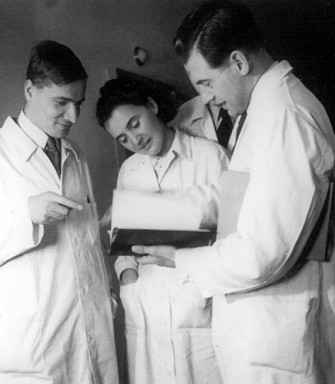 Mengele as an associate of Von Verschuers’s institution for genetics in Frankfurt in the late 30s. Source: Max-Planck Gesellschaft Berlijn-Dahlem.
Mengele as an associate of Von Verschuers’s institution for genetics in Frankfurt in the late 30s. Source: Max-Planck Gesellschaft Berlijn-Dahlem.In the N.S.D.A.P. and service at the front
It may seem plausible that a racial scientist like Mengele would be a member of the N.S.D.A.P. and yet, it took until May 1937 before he joined Hitler’s party. His father, Karl Mengele, had already preceeded him in 1933. This was after the entrepreneur had made his construction hall available for an election meeting of the party where he had met Hitler (Bio Hitler). Possibly, Josef joined the party later as his scientific career took priortity over his political life that he had temporarily ended by canceling his SA membership in 1934. Meantine however, from the perspective of his career, it was inevitable to be a member of the Nazi party. Yet, it would not have been for opportunistic reasons alone that he joined the N.S.D.A.P., because Hitler’s views matched the conservative and nationalistic norms and values he had adopted during his upbringing and his years in school and university. A year after he had joined the N.S.D.A.P., Mengele joined the Schutzstaffel (SS). He also was a member of the "Nationalsozialistischer Deutscher Ärztebund" (Nationalsocialist Association of German physicians), the professional organisation of physicians.
Meanwhile, Mengele had married Irene Maria Schönbein in July 1939. During his internship in Leipzig in 1936, he had met this nurse who was then 19 years of age. She was a member of the Bund Deutscher Mädel (B.D.M., Association of German girls) since 1934 and studied French and art history. The couple would have just one child, Rolf who was born in March 1944. During the war, mother and son had to make do without the company of their husband and father for most of the time. In contrast to most of Von Verschuer’s asisstants, Mengele was not immediately drafted into the Wehrmacht at the oubreak of war. Probably because of a kidney disease and fragile bone structure, he was declared temporarily unfit and just had to keep himself available. For the time being, he continued his work at Von Verschuer’s institution in Frankfurt.
Earlier, from October 1938 until January 1939, he did complete his compulsory military service, shortened to three months, in the 19. Kompanie, Gebirgsjägerregiment 137 (mountain troops) in Saalfelden am Steinersee in Tirol. On 15 June 1940 he was drafted for military service anyway into the Sanitäts-Ersatz Battalion 9 (Medical reserve battalion), stationed in Kassel. His tenure in the Wehrmacht was of short duration however because on 12 July he applied for the Waffen-SS.
On 1 August 1940, Mengele entered service in the "Sanitätsinspektion der Waffen-SS" , the medical branch of the Waffen-SS, in the rank of SS-Hauptscharführer. He attended a course for military physician and was promoted to SS-Untersturmführer, effective as from the day he entered service. It would still take a while though before he would see service at the front as a medical doctor because from 11 August 1940 onwards, he was employed at the "Rasse- und Siedlungshauptamt", the department of the SS which handled racial affairs. He was dispatched to Poland as a representative of the "Hauptamt Reichskommissariat für die Festigung Deutschen Volkstums" , the SS agency charged with maintaining and protecting racial standards and the expansion of the Germanic race outside Germany. From Posen he was probably stationed in the vicinity of Lodz at an immigration center where he was involved in checking the hereditary and mental health of the local Volksdeutsche to determine whether they were could be allowed to return to the Reich.
Early 1941, Mengele was appointed physician in the SS-Panzer-Pioneer-Battalion 5 of the SS-Panzerdivision Wiking. He took part in Operation Barbarossa, the German invasion of the Soviet Union. His commander called him a capable physician. At the end of 1941 he was promoted to SS-Obersturmführer. In 1942 he was seriously injured and was awarded the Verwundetenabzeichen in Schwarz (Wounded Medal in Black). During his stay at the Eastern front, he was also awarded the Eisernes Kreuz 1ste und 2te Klasse (EK, Iron Cross 1st and 2nd class). He probably received his EK 1 for having rescued under fire two seriously injured soldiers from a burning tank during the fighting at Batasjk and Rostov on the Don in July 1942. The exact date of and reason for his return from the front are unknown but he probably returned to Germany in 1943 because of his injuries.
Definitielijst
- Eisernes Kreuz
- Iron Cross. German military decoration.
- invasion
- Armed incursion.
- Iron Cross
- English translation of the German decoration Eisernes Kreuz.
- Nazi
- Abbreviation of a national socialist.
- Schutzstaffel (SS)
- The Schutzstaffel commanded by Heinrich Himmler was a very powerful organisation within the Third Reich. The original goal of the SS was to protect Adolf Hitler and other Nazi’s but soon the SS was deployed for several military, security and police tasks. The SS guarded inter alia the concentration camps and manned the Einzatzgruppen. The armed branch of the SS was the Waffen-SS.
- Soviet Union
- Soviet Russia, alternative name for the USSR.
- Waffen-SS
- Name of Military section of the SS.
- Wehrmacht
- German armed military forces, divided in ground forces, air force and navy.
Images
Physician in Auschwitz
Back in Germany, Mengele was posted to the SS-Ersatzbattalion Ost. In his spare time he again worked for his mentor, Otmar Freiherr von Verschuer who in the mean time had been appointed director of the aforementioned Kaiser Wilhelm Institut in Berlin. As of 20 April 1943, Mengele was promoted to SS-Hauptsturmführer. It had probably been Von Verschuer who had seen to it that Mengele was transferred to the concentration and extermination camp Auschwitz on 30 May. Here a large potential of guinea pigs was at his disposal that could be used for the medical experiments for the good of the scientific racial research of Von Verschuer’s institute.
These experiments in particular and his involvement in the selection of victims for the gas chambers made Mengele one of the most wanted Nazi criminals after the war. He worked In Auschwitz until January 1945, in total 19 months, most of the time in the extermination camp Birkenau, situated 1.86 miles from the Stammlager (main camp) and which had four crematoria with gas chambers available were the systematic extermination of Jews and Gypsies was carried out. Mengele was housed in one of the so-called doctors houses near the Stammlager. While some wives of members of the camp staff moved in with their husbands in Auschwitz, this did not apply to Irene Mengele. She stayed behind in Günzburg but she would visit her husband in August 1944.
Although it has been presented sometimes in popular literature in this way, Mengele was neither the only camp doctor in Auschwitz, nor the highest ranking. During the period he worked in the camp, the medical staff consisted of 30 doctors. A total of 38 physicians and dentists who had worked in Auschwitz are known by name. In addition an unknown number of pharmacists and nurses worked in the camp. In charge of the medical staff in the camp was a SS-Standortartz; from 1 September 1942 onwards, that was SS-Hauptsturmführer Dr. Eduard Wirths. In theory, the medical staff of the SS was responsible for the health of both the personnel of the camp and the inmates but especially in an extermination camp like Birkenau, the inmates could not count on sound medical treatment by SS doctors. The doctors usually delegated treatment of patients in the hospital barracks to nurses of the SS and more often to doctors and nurses from among the inmates themselves who often could do little to alleviate or improve the fate of their patients owing to the severe shortage of medicine and instruments.
Mengele worked as Leitender Lagerarzt (chief physician) in the Gypsy section (Lager B IIe) in Birkenau. Here he also began selecting victims for his experiments. Initially these involved innocent tests where for instance body size and proportion of the bodies of twins and little people were measured. Remarkably enough, in view of his future notorious reputation, initially he seemed to be on the best of terms with the inmates. He improved living conditions in the Gypsy section and founded a kindergarten for children up to six years. The youngest of them sometimes were treated to a little extra such as milk or chocolate. He even set up a small playground for them with a sandpit and swings. "Dr. Mengele was liked very much by us," former inmate Adam Strauss declared, "because he did something special for the Gypsies. Especially for the children he did something extra so they could eat regularly. […] When he arrived in the Gypsy camp, the situation improved perceptibly. I have also seen that Mengele came to the rescue when a Gypsy was being beaten up."
Behind the mask of the benevolent doctor however, somebody was hidden who only acted out of self interest. By winning the sympathy and trust of his prisoners, they would all too easily co-operate in his medical experiments. Mengele also dropped his benevolent mask in other ways. Just like the other doctors, he was responsible for fighting epidemics in the camp. The delousing operations he launched were a torment to the prisoners in the Gypsy camp. They had to leave their barracks and take off all their clothes. Regardless of weather conditions and even in winter they were then deloused and desinfected in the open air. Subsequently they had to wait a long time while in the meantime their barracks and clothing were being cleaned. In the spring of 1944, Mengele applied an even more horrendous method. In order to combat scabies, prisoners had to immerse in two baths, one with sodium sulfuric acid and one with chloric acid. Following that they had to wait again, naked in the open air until their clothing and barracks had been cleaned also.
Mengele and his fellow doctors applied a far more rigorous method to combat epidemics though. When typhoid had broken out in a shed, all occupants were removed and gassed. Subsequently the shed was cleaned to make room for the next group of inmates. Mengele has frequently been involved or been responsible for such actions. On 25 May 1943 for instance, shortly after his arrival in Auschwitz, he sent 507 male and 528 female Gypsies to the gas chambers because he suspected them of having contracted typhoid. On 26 April 1944, Mengele was awarded the "Kriegsverdienstkreuz mit Schwertern" (Service Cross with Swords), not in the least for his contribution in combatting epidemics. "Despite the fact that this is no rare honour," he wrote in a letter to his wife on the same day, "and even despite the fact that I already possess higher decorations, I was touched by the recognition of my work and my devotion. My work sometimes threatens my own health and even my life; that is why I was very grateful." He also remarked that he and his colleague, Dr. Heinz Thilo, Leitender Lagerarzt of the prison hospital, who had received the same award, mockingly called this decoration the typhoid medal.
On 2 August 1944, the Gypsy camp at Birkenau was closed down. Mengele selected the prisoners from this part of the camp: some 3.000 of them were gassed and some 1.400 prisoners, capable of work were transferred to concentration camp Buchenwald. After the liquidation of the Gypsy camp, Mengele was appointed successor to Dr. Heinz Thilo as Leitender Lagerarzt of the hospital for men at Birkenau (Lager B IIf). That month, his wife paid a visit to Auschwitz. Initially she was to stay for a month but she contracted diphteria and had to be admitted to the SS hospital in the Stammlager. As late as 30 October she had recuperated suffciently to return to Günzburg. Mengele went home with her on leave and met their son Rolf, who was then six months old, for the first time.
Definitielijst
- concentration camp
- Closed camp where people are being held captive that are considered to be anti- social, enemies of the state, criminal or unwanted individuals. These groups mostly do not get a fair trial or are condemned to doing time in a camp.
- Jews
- Middle Eastern people with own religion that lived in Palestine. They distinguished themselves by their strong monotheism and the strict observance of the Law and tradition. During World War 2 the Jewish people were ruthlessly persecuted and annihilated by the German Nazis. . An estimated 6,000,000 Jews were exterminated.
- Nazi
- Abbreviation of a national socialist.
- Stammlager
- Main or base camp. One of the 22 concentration camps with multiple subsidiary external camps.
Images
Selection
An important task for the SS doctors in Auschwitz was selection. From the beginning of 1942 onwards, trainloads of prisoners consisting mainly of Jews from different European countries arrived in Birkenau almost on a daily base. In principle, only prisoners capable of work were detained in the extermination camp for a longer period to do forced labor. People unfit to work, such as the elderly, children and the disabled arriving on the transports were usually sent to the gas chambers immediately on arrival. The Jewish physician and pathologist, Dr. Miklós Nyiszli, who as a prisoner assisted Mengele with his selections and medical experiments, testified: "the people who had just arrived were divided in a left and a right row. The right meant life, the left: to the crematoria. Percentagewise about 75 to 80 % were sent to the left." Prisoners who became unfit for work as a result of starvation, exhaustion or sickness during their stay in the camp, eventually underwent the same fate. On the arrival platform (die Rampe) as well as inside the camp itself, it was Mengele’s task and that of his colleagues to make selections to determine whether someone was fit to work or not. Mengele’s notoriety was determined equally by these activities as by his experiments.
After the war, many former prisoners remembered how they first saw Mengele on the platform when they arrived, impeccably dressed and entirely at ease. "He behaved gallantly and radiated a quiet self confidence hovering between complaceny and utmost charm," according to Arminio Wachsberger from Rome. "He whistled a Wagner aria while he directed prisoners to either left or right.". A former prisoner from Czechia, Zdenka Ehrlich stated that she would never forget "the impression of this man. I looked at him for a short time only, he was very handsome. Not a threatening face at all, more likely …. unbenevolent but not threatening. I remember his shiny boots, he was absolutely impeccable. He wore white gloves, not as a policeman directing traffic but as a token of distinction and importance. He raised his hand as he looked at everyone who passed by and he only made a slight gesture when he said: right, left, left, left, right, left, right….". The elegant way in which Mengele decided on life and death in Birkenau earned him the nickanme ‘the angel of death’. He acted in this way mainly for the benefit of the extermination process: by putting the victims at ease by his charms, they left for the gas chambers without suspicion. Only when people refused to be separated from their familiy members did he use violence and whipped them with his horse whip.
A typical example of the ambiguity of Mengele’s actions was given after the war by SS guard Richard Boeck, who rememberd how Mengele had taken care of an old woman who had fallen off the truck which should have taken her to gas chambers. He helped her get up and personally accompanied her to the gas chamber where she was killed. One of Mengele’s colleagues, the Lagerarzt in Auschwitz III Monowitz, Dr. Horst Fischer declared that Mengele was convinced the Jews should be exterminated. "He was the most firmly convinced SS man we had". At the Auschwitz trial in Frankfurt from 1963 to 1965, where Mengele himself did not stand trial by the way, it was established that he had made 74 selections on the platform of Birkenau in the period between June 1943 until the fall of 1944; the exact number is presumably higher. Mengele probably made more selections than most of his colleagues, also because he had worked in Auschwitz longer than most other doctors. An explanation for the fact that he could be seen on the platform frequently may also be that he was present to select special persons such as twins and little people for his experiments. His conspicuous outward appearance may have caused people to still remember him but no other doctors after the war.
Mengele not only made selections on the platform but inside the camp as well. For instance, in the period between 28 August 1943 and 29 October 1944 he was, along with other colleagues responsible for 15 selections in the quarantaine camp (Lager B IIa) when 3.824 prisoners were sent to the gas chamber. If only a small number of prisoners were to be killed, they were not sent to the gas chamber but injected with a lethal drug such as phenol. Mengel’s assistant, Miklós Nyiszli testified how Mengele once killed 14 Gypsy twins in this way. The first victim was a 14 year old girl. "Dr. Mengele ordered me to undress the girl," the Hungarian doctor declared, "and to lay her on the dressing table. Then he injected Evipal in a vein in her left arm. Once the child had fallen asleep, he looked for her left heart chamber and pushed in the syringe with 10 cc of chlorophorm. After a little shock, the girl died and Mengele had her taken to the morgue. In this way, all 14 twins were killed that night."
Sometimes, Mengele made selections in the women’s camp as well and checked if they were pregnant. When that happened to be the case, he sent them to the gas chamber or he performed an abortion. Women in the extermination camp were to be prevented from having offspring. It appears from eyewitness accounts that Mengele performed the gyneacological examinations very crudely and that the circumstances in which he performed abortions were also very bad. There was a lack of required instruments and desinfectants. The Jewish gyneacologist Dr. Gisella Perl, who was employed in Birkenau as a doctor, managed to save the lives of many women by performing abortions on them before Mengele would find out they were pregnant.
Definitielijst
- Jews
- Middle Eastern people with own religion that lived in Palestine. They distinguished themselves by their strong monotheism and the strict observance of the Law and tradition. During World War 2 the Jewish people were ruthlessly persecuted and annihilated by the German Nazis. . An estimated 6,000,000 Jews were exterminated.
Images
Medical experiments
Almost immediately after arriving in Auschwitz, Mengele began performing medical experiments on inmates (Gypsies and Jews). He was not unique in this because other SS doctors in Auschwitz and other concentration camps were involved in this. For instance, Dr. Sigmund Rascher conducted experiments in Dachau where prisoners were subjected to high pressure and hypothermia - often with fatal consequences - to determine the chances of survival of air force personnel at great heights and after they had ditched in cold sea water. Another doctor in Dachau, Dr. Klaus Schilling, injected inmates with malaria parasites in order to test drugs against this disease. In Auschwitz, gyneacologists Dr. Carl Clauberg and Dr. Horst Schumann carried out experiments in order to find a method to sterilise large numbers of racial inferior people. They subjected their victims to X-rays for instance, resulting in excruciating pains and physical damage. Many guinea pigs of these SS doctors died or became permanently disabled. Mengele’s test persons fared no differently. Other than his colleagues however, Mengele performed a wide variety of experiments both in the field of medicine as well as when National socialist genetics and racial science were central issues. As he had worked in Auschwitz for a long time in comparison to most other doctors, the number of experiments performed by him is relatively large.
Mengele’s research in Auschwitz was funded with part of the allowance from the Deutsche Forschungsgemeinschaft (D.F.G. or German research institute) that Otmar von Verschuer received. Von Verschuer gave Mengele a free hand to do research on anything he wanted, provided that the results be made available to the Kaiser Wilhelm Institut in Berlin. During his stay in Auschwitz, Mengele would therefore send much material to Berlin, included conserved body parts. SS leader Heinrich Himmler (Bio Himmler) had approved of Mengele’s work, as is clear from a letter Von Verschuer wrote to the D.F.G. in which he reported that his assistant "is presently employed as camp doctor with the rank of SS-Hauptsturmführer in concentration camp Auschwitz. In this camp, anthropological research is carried out among various races under the direction of and with permission from SS-Reichsführer Himmler." In doing this research, Mengele called on assistance by inmates of whom the Hungarian pathologist Miklós Nyiszli is the best known. Nyiszli performed post mortems on the bodies of test persons and prepared body parts for further analysis. He survived the war and in 1946 he published a book about his experiences in Auschwitz.
Descriptions of Mengele’s experiments mainly originated from survivors and eyewitnesses like Miklós Nyiszli. One account is even more gruesome than the next. It is hard to establish the correctness of each and every testimony but the number of gruesome accounts is so high that it can be assumed that many of them are truthful. What has come to our knowledge in this way is that Mengele performed bonemarrow transplants without sedation. He also experimented with methods of treating noma, a disease especially young children suffer from and which appeared in the Gypsy camp only. Noma is a bacterial disease, caused by extreme malnutrition and an additional infection such as typhoid, characterised by the gradual decay of the tissue in mouth and cheeks, resulting in teeth, gums and chinbone being laid bare. Mengele recorded the progress of the disease and had patients photographed. By administering drugs and special nutrition he managed to cure them but by subsequently aborting the treatment, the disease returned. He also infected healthy testpersons with saliva from the mouth of noma patients. He had patients beheaded after death, their heads being preserved in glass jars which were subsequently sent to Berlin for further analysis.
Although gyneacology was not his specialty, Mengele also conducted experiments on pregnant women. He had them infected with typhoid in order to determine whether their children would be born with the infection too. In another experiment, he encased the breasts of a mother with a new born child in plaster to see how long the baby could survive without milk. The Jewess Ruth Elias and her baby suffered from this treatment. "My child passed away very slowly, " she declared. "It hardly cried anymore, it just moaned." After eight days, the baby hardly gave any signs of life and an inmate doctor injected the child with morphine. Mengele also participated in the sterilisation experiments by Clauberg and Schumann. Men as well as women fell victim to these experiments in which sterilisation was carried out both by operation and otherwise (by means of injecting acid in their oviducts or subjecting them to X-rays).
In yet another experiment, Mengele subjected his victims to electrical shocks in order to determine the maximum voltage a person could stand. Many test persons are presumed to have died from this experiment. Mengele’s experiment on changing the color of the iris of young children by injecting methylblue into the eyeball is also notorious. The procedure did not cause permanent change but did cause severe pain and in some cases permanent damage to the eyesight. Probably 36 children had to undergo this experiment. One can only guess as to the meaning of this experiment; it is often suggested that Mengele intended to create a super race that would match the Arian notion of beauty (blue eyes and blond hair). Some distinction is necessary however as his guinea pigs were Jews and Gypsies who, according to the Nazi doctrine were inferior and so were not the suitable material for the creation of a super race. It is more likely that these experiments were part of the work of Dr. Karin Magnussen of the Kaiser Wilhelm Institut. She investigated the phenomenon of heterochromy, people having two eyes of different color. To the benefit of this research, Mengele had numerous eyeballs of his victims sent to Berlin.
Mengele also send human material to the Kaiser Wilhelm Institut for anthropology in Berlin to be examined by biogeneticians. This included for instance skeletons of disformed people and those suffering from dwarfism. Mengele displayed a special interest in these aberrations. On the platform he specificly selected people with differing physical characteristics. On 19 May 1944, a transport arrived from Hungary including the Romanian-Jewish family of artists, Ovitz. Seven of them suffered from dwarfism. Mengele seperated the family from the other prisoners and transferred them to a special section of the camp. He hoped to discover the cause of dwarfism so he could gain scientific honour from it. The dwarfs were subjected to injections of drugs, bonemarrow transplants, blood was taken from them and the women fell victim to experiments with sterilisation. Except for one, all members of the familiy survived the war, including the seven dwarfs. They would all emigrate to Israel, the last member of the family passed away in 2001. It is remarkable about their story that they owed their lives to the same man who had abused them as test persons. If Mengele had paid no special interest to them, they would have been gassed immediately on arrival in Auschwitz.
Definitielijst
- concentration camp
- Closed camp where people are being held captive that are considered to be anti- social, enemies of the state, criminal or unwanted individuals. These groups mostly do not get a fair trial or are condemned to doing time in a camp.
- Jews
- Middle Eastern people with own religion that lived in Palestine. They distinguished themselves by their strong monotheism and the strict observance of the Law and tradition. During World War 2 the Jewish people were ruthlessly persecuted and annihilated by the German Nazis. . An estimated 6,000,000 Jews were exterminated.
- Nazi
- Abbreviation of a national socialist.
Images
 Dr. Sigmund Rascher, a colleague of Mengele, during an experiment on hypothermia in Dachau, 1942. Source: DIZ Munich.
Dr. Sigmund Rascher, a colleague of Mengele, during an experiment on hypothermia in Dachau, 1942. Source: DIZ Munich.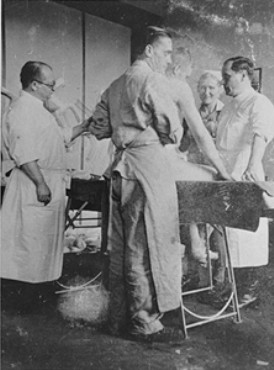 Carl Clauberg (left), another colleague of Mengele who was engaged in experiments on sterilisation in Auschwitz. Source: Instytut Pamieci Narodowej.
Carl Clauberg (left), another colleague of Mengele who was engaged in experiments on sterilisation in Auschwitz. Source: Instytut Pamieci Narodowej.Examination of twins
Apart from his interest in dwarfs and people with other rare physical aberrations, Mengele was also interested in twins. In the spring of 1944, he started experiments on them. He was probaly encouraged to do so by Otmar von Verschuer who had made a name for himself in research on twins. Mengele probably saw this subject as a chance to rise in the scientific fraternity. It has once been suggested it was his intention to discover the genetic code for twins so the Arian race could multiply faster, but this seems to be far fetched. A more likely reason is that according to Von Verschuer, genetic influence could be best studied on twins. Instead of comparing two different people, two seemingly identical people could be compared. "In the world history of medicine, this was a unique phenomenon," as Mengele’s asistant, Dr. Miklós Nyiszli declared. "Two brothers died simultaneously and it was possible to perform autopsy on both. Where can you find, under normal circumstances, twin brothers who die in the same place at the same time?"
Especially uniovular twins younger than 16 were used by Mengele for his experiments. Initially he selected them in the Gypsy camp and the family camp (Lager B IIb) in Birkenau, but later on he selected them on the arrival platform. The children were separated from their parents who were usually gassed. Only the mothers of very young children were kept alive so they could take care of them. The twins were exclusively made available to Mengele. He had them housed in an empty shed in the Gypsy camp and after the liquidation of this camp, they were transferred to a special section in the women’s camp (Lager B Ia). In contrast to the other inmates, their heads were not shaved and they were allowed to wear their own clothes. They were exempted from the daily selections and did not have to do forced labor. Mengele also prohibited the twins to be beaten or maltreated as this could influence the result of his examinations. The experiments he carried out on them however, were just as gruesoem as those on his othert test persons.
Mengele injected the children with or covered them in chemicals to see how both halves of the twins would react. To the same end he drew blood from them. According to Yitzhak Taub, one of the twins who fell victim to Mengele’s experiments, so much blood was drawn from them that they "fell to the ground like empty plasic bags." Other victims were 10 year old Eva Mozes Kor and her twin sister Miriam. Eva rememberd how "three times a week, my arms were tied up to block circulation and they drew much blood from my left arm, once so much that I fainted. While drawing blood, they gave me at least five injections in my right arm. After one of those injections I fell very ill and the next morning, Dr. Mengele came along with four other doctors. He looked at the temperature chart and said with a sadistic smile: ‘What a pity, she is still so young. She has just three more weeks to live.’ I constantly lost consciousness and while I was semi conscious I said to myself all the time: ‘I must stay alive, I must stay alive’. They were waiting for me to die. Had I died, my twin sister Miriam would have been taken to Mengele’s laboratory straight away and would have been killed by an injection in the heart after which Mengele would have performed the comparing autopsies."
It was standard procedure that when one half of twins died, the other was also killed by Mengele in order to compare their organs by means of post mortem. The children were also subjected to various surgical procedures, often without sedation, where Mengele compared the thresshold of pain of the two halves of the twins. Probably the most gruesome example of an experiment is when Mengele sewed the two halves of four year old twins together. "Like Siamese twins, they were sewn together back to back," Vera Alexander declared, who worked as a nurse in the twins section in the Gypsy camp. "Their wounds festered horribly and they cried day and night." Both children died. How many twins were killed by Mengele is unclear. According to an estmate of the Pole Tadeusz Joachimovski, who worked in Mengele’s office, there were 200 cases of death out of a total of 250 twins. According to another estimate, some 15% died. On liberation of the camp on 27 January 1945, 72 younger twins were found alive. The fate of the older twins, who were evacuated in January 1945 is unknown.
Images
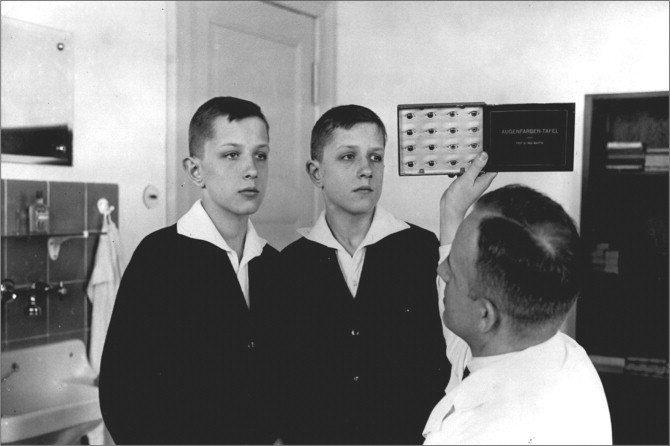 Otmar Verschuer, Mengele’s mentor, was a famous researcher on twins himself. Here he examines twins at the Kaiser Wilhelm Institut in Berlin. Source: Max-Planck Gesellschaft Berlijn-Dahlem.
Otmar Verschuer, Mengele’s mentor, was a famous researcher on twins himself. Here he examines twins at the Kaiser Wilhelm Institut in Berlin. Source: Max-Planck Gesellschaft Berlijn-Dahlem.On the run
Mengele’s experiments came to a halt in early December 1944, just two weeks before the evacuation of Auschwitz. Because the Red Army was closing in, burning of the administration of the camp was started in order to destroy the evidence of the crimes that had been committed in the camp. The crematoria and the gas chambers were also torn down. Wilhelm Brasse, who survived Auschwitz, testified after the war that he and a fellow inmate were ordered by Mengele to burn pictures and films of his experiments. Not all of Mengele’s research material was destroyed though, according to a statement by inmate doctor Marina Puzyna. She declared that Mengele left the day of the evacuation of the camp, taking as much records of research data with him, especially of twins and dwarfs. With these records in his luggage, Mengele left Auschwitz by car, destination concentration camp Gross-Rosen in Lower-Silesia (today Polish territory). Late January he was appointed SS-Standortarzt in Gross-Rosen by Dr. Emil Lolling, chief physician of Amt D of the W.V.H.A. (Wirtschafts und Verwaltungshauptamt or Inspectorate of the concentration camps).
Being SS-Standortarzt, Mengele was the highest ranking physician in the camp. He was in charge of the medical personnel and was responsible for all medical affairs in the main camp as well in the satellite camps of Gross-Rosen. Little is known about his work in Gross-Rosen but in one of the satellite camps, Mengele is said to have made selections among typhoid patients, just like in Auschwitz. His stay in Gross-Rosen was of short duration though because as early as 8 February, evacuation of the camp was begun as the Red Army was steadily advancing on it. The camp would be liberated on 13 February. A few days before, Mengele was posted to an satellite camp of Gross-Rosen, a labor camp in Reichenau, today Rychnov u Jablonce nad Nisou in Czechia. At the end of April, shortly before the liberation of the camp on 8 May by the Red Army, Mengele fled westwards in order to stay out of Soviet hands.
Disguised in a Wehrmacht uniform, Mengele reached Saaz (now Žatec in Czechia) on 2 May. In a field hospital located there, he encountered Dr. Otto-Hans Kahler, a former colleague from the Kaiser Wilhelm Institut. Kahler saw to it that Mengele received permission to join the field hospital. In that period, Mengele entered into a relationship with a nurse, to whom he handed the records of his experiments so they would be kept out of Allied hands. On the day of the German capitulation, 8 May the field hospital and Mengele had been moved to the no-man’s land between the American and the Soviet fronts in the vicinity of Karlsbad. Following the annexation of the area in June by the Americans, the entire unit, including Mengele was taken prisoner of war. In the period that followed, Mengele would be interned in various prisoner of war camps. Despite the fact that he already appeared on a list of wanted war criminals, the Americans failed to discover his real identity. He called himself Joseph Memling and enjoyed the great advantage to have refused to have his blood group tattoed, out of vanity, on the inside of his left upperarm, which was normal for soldiers of the Waffen-SS. After just six weeks, in August 1945, he was set free by the Americans.
For a few weeks, Mengele was to have no fixed stay but with the aid of a pharmacist friend in Munich, an accomodation was found for him in November 1945 where he was to stay until August 1948. It was the Lechnerhof, an out-of-the-way farm, owned by the couple Georg and Maria Fischer, in Mandoling, eastern Bavaria, some 43.5 miles from Munich. Mengele was employed as a farmhand and was known to them as Fritz Hollmann. On the farm, Mengele made long hours, mucking out stables, milking cows and sorting the harvest of potatoes. The family suspected their farmhand to be a Nazi on the run but they were satisfied with his work and let it rest. In his years at the farm, Mengele kept in touch with his family. His wife visited him numerous times and he himself would travel to Autenried in Bavaria with forged papers in order to visit his family, taking an enormous risk in doing so. The marriage to his wife meanwhile showed deep cracks and they quarelled often during their meetings. They would divorce a few years later.
Definitielijst
- capitulation
- Agreement between fighting parties concerning the surrender of a country or an army.
- concentration camp
- Closed camp where people are being held captive that are considered to be anti- social, enemies of the state, criminal or unwanted individuals. These groups mostly do not get a fair trial or are condemned to doing time in a camp.
- Nazi
- Abbreviation of a national socialist.
- Red Army
- Army of the Soviet Union.
- Waffen-SS
- Name of Military section of the SS.
- Wehrmacht
- German armed military forces, divided in ground forces, air force and navy.
Images
In South-America
The hard and monotonous labor, the problems with his wife and the fact that there was no future for him in Germany any more, being a fugitive war criminal, made Mengele decide to emigrate on his own. In August 1948 he left the farm in order to make preparations for his journey to Argentina Thereafter he probably stayed in a forest in the vicinity of Günzburg. His family, which was doing very well economically thanks to their factory, put together 7.000 Mark and a forged Italian passport in the name of Helmut Gregor was bought. Although there is no conclusive evidence for this, Mengele was probably assisted with his flight by Carlos Fuldner, a former SS-Hauptsturmführer of Argentinian-German descent. Fuldner had fled to his native country in 1947 were he founded an organisation which would help numerous fugitive Nazis to emigrate to Argentina, including Adolf Eichmann (Bio Eichmann). Under the regime of dictator Juan Peron, hundreds of Nazi war criminals found a safe haven in Argentina.
Mengele traveled via Sterzing and Bolzano in the Italian province of southern Tirol to Milan and finally arrived in Genoa on 20 May 1949. In this port he received a passport from the Red Cross, a medical declaration and an Argentinian immigrant visa. He almost failed at the last moment because the official who was to hand him, against payment, an Italian emigration permit was on vacation and his colleague could not be bribed. Mengele was detained for four days by the Italian border police but was released when the corrupt official returned from his vacation. On 25 May 1949 Mengele left, destination Argentina aboard the vessel North King. The ship entered the port of Buenos Aires on 20 June 1949. Mengele was to stay in the city until 1959. He would spent the best years of his post war life there.
In Buenos Aires, Mengele joined the large community of German immigrants. He met, among others, Hans-Ulrich Rudel, a highly decorated Luftwaffe fighterpilot and leader of Kameradenwerk, an organisation supporting Nazis who had fled. Thanks to these contacts and the financial support by his family in Germany, Mengele managed to make a good living for himself. In the early 50s he commenced work as overseas representative of the factory of agricultural machinery owned by the Mengele dynasty. He also founded a woodwork factory and became partner in a pharmaceutical company. In 1954 the divorce from his wife was set in motion. In a lively exchange of letters with his sister in law, Martha, the widow of his brother Karl jr., who had passed away in 1949, a romance blossomed between the two. In March 1956, the two met in the wintersports village of Engelberg in Switzerland. Mengele also met his son there, now 12 years old, for the first time since the war. In October 1956, Martha and her son Karl-Heinz would join Mengele in Buenos Aires. They moved in with him. In July 1958, Mengele would marry Martha in Nueva Helvecia in Uruguay.
The trip from Argentina to Switzerland via New York and Geneva and back went without a hitch for Mengele. He felt so secure by this that he decided, after having returned to Argentina, to have himself registered at the German Embassy under his own name. For his marriage to Martha, he needed a German birth certificate anyway. This also was accomplished without a hitch and he was given a German passport. That year he did get into trouble when he was arrested by the Argentinian police because he had been accused of having been responsible for the death of a girl after an illegal abortion. He problably was not the culprit however and he was released again after just three days. For Mengele, bigger problems arose on 25 February 1959 however when a warrant for his arrest was issued in Germany for the first time. The ground under his feet now became too hot for him and he left Argentina for Paraguay where he went into hiding. As his real name had been recorded by the German Embassy it would not have been too complicated to track him down. Yet, as late as 30 June 1960, Germany would request Mengele’s extradition from Argentina.
While Martha and her son stayed behind in Argentina - the relation between Mengele and her had cooled down and she returned to Europe in 1961. Mengele stayed on a farm, owned by a friend of Rudel, near Hohenau in the southeast of Paraguay for 15 months. On 27 November 1959, he was granted the Paraguayan nationality as José Mengele, which guaranteed that he could not be extradited to West-Germany. He knew of the efforts that were being made in the Federal Republic to track him down and he had also heard of the kidnap of Adolf Eichmann on 11 May 1960 by the Israeli secret service, the Mossad. In October 1960 he decided to leave Paraguay and he traveled to Brazil on a forged passport in the name of Peter Hochbichler. He was to stay there until his death. From 1961 to 1975 he stayed with the Hungarian immigrants Gitta and Geza Stammer, initially on their farm in Nova Europa, more than 186.4 miles northwest of São Paulo and from 1962 onwards on their new farm near Sierra Negra, some 93.2 miles northwest of São Paulo.
During the time he stayed with the Stammers, Mengele suffered from depressions. The tension between him and the family ran so high that he moved to a small dilapidated house in Eldorado, a run down suburb of São Paulo in 1975. This would be his final residence. While he spent his last years mostly in loneliness, the hunt for him continued, especially by Nazi hunter Simon Wiesenthal. He was however continuously on the wrong track. He claimed he had nearly caught Mengele in 1961 on the Greek island of Kythnos. Earlier, Mengele would have found lodging in Egypt, according to him. In the 70s, Wiesenthal reported he had traced Mengele in Paraguay and in 1972, the Nazi doctor even had allegedly been spotted in the Spanish vacation resort of Torremolinos.
Someone who did know the real whereabouts of his father was his son Rolf. He visited his father, whom he had not seen for 21 years, in 1977 in Brazil. Meanwhile, his father’s name had become notorious in the western world. Much was written about him, both in fiction and in non-fiction. Best known is the novel by Ira Levin, The Boys from Brazil, published in 1976 and made into a movie two years later. Levin situated Mengele in a colonial mansion in the South-American jungle where he kept busy cloning 94 Hitlers. Rolf knew about the charges brought against his father in the media and he wanted to hear his side of the story. However, he did not get a satisfactory answer from the embittered man. "His arguments that some races were superior to others were entirely unscientific," Rolf Mengele declared. "He talked all kinds of nonsense, for instance when I asked him why so many disabled and deformed people were so bright and well educated." His father only claimed to have done his duty and even maintained he had saved human lives by not having sent them to the gas chambers during selections. Rolf concluded his father was not tormented by repentance or a feeling of guilt but only by the fear of being taken prisoner himself. Rolf stayed in Brazil for two weeks and thereafter returned to Germany again. It would be the last time he saw his father.
In the final months of his life, Mengele suffered from changing moods and depression. He was taken into the care of a befriended couple, Wolfram and Liselotte Bossert. They invited him to stay with them for a few days in their little house in Bertioga Beach. Mengele arrived there on 5 February 1979. Two days later, while swimming, he suffered a stroke. Wolfram Bossert managed to drag him ashore and performed cardiac pulmonary resuscitation but to no avail. The stroke had been fatal. He was buried on 8 February as Wolfgang Gerhard on the cemetery of Nossa Senhora Rosário in Embu, a small suburb of São Paulo. Only the Bosserts and a priest were present at the burial. News of his death reached Rolf and the rest of the family in March 1979. They kept his demise secret from the world. Wiesenthal continued searching for Mengele and claimed numerous times he had found him. In 1984 he claimed that is was 99% sure that the Nazi doctor was in Paraguay. The Federal German Republic issued a renewed warrant for his arrest in 1982 and offered, just like Israel did, a large amout of money for the tip that would lead to his arrest.
In 1985 it finally became known that the grave of Wolgang Gerhard was in fact the final resting place of Joseph Mengele. In the house of Hans Sedlmeier, a friend of Mengele from his youth and salesmanager of the Mengele factory, German police discovered letters to and from Mengele with the Bossert’s address on them. Subsequently, the Brazilian police conducted a house search of the Bossert family and discovered still more personal documents that had belonged to Mengele. In an interrogation by German police officers who had traveled to Brazil, the Bosserts confessed to the location of Mengele’s grave.
On 5 June 1985, in the presence of a large press audience, Mengele’s remains were exhumed in the cemetry of Embu. On 21 June 1985, American experts at the police station of São Paulo announced that forensic research had shown that the remains had been identified, beyond a reasonable doubt, as belonging to Mengele. This was not sufficient however to convince the Simon Wiesenthal Center in Los Angeles and the Israeli police. Simon Wiesenthal kept thinking that Mengele’s death had been enacted. In the media, reports still appeared that Mengele had been seen in various locations in South-America after his death. By means of a DNA test in 1992, conducted by the British genetician Dr. Alfred Jeffreys, a clear match was found between the DNA from the exhumed bones and that of Rolf Mengele. This was incontrovertable proof for the fact that the notorious Nazi doctor had indeed died in 1979.
Definitielijst
- Luftwaffe
- German air force.
- Nazi
- Abbreviation of a national socialist.
Images
Epilogue
Even long after it had been established that Joseph Mengele had passed away, his name kept popping up in the media frequently. In 2009, international news sources drew attention to the rumor that a baby boom of twins in the Brazilian village of Cândido Godói had been the work of Mengele. During the time he lived in Brazil, he allegedly would have administered an hormonal medicine to the women of the village resulting in more twins being born. Closer investigation by the State university of Rio Grande do Sul showed however that the baby boom of twins had already begun in the 30s and so could not be attributed to Mengele. That these rumors were greedily taken up by the international media is all due to the forming of myths around Mengele’s person. In popular fiction, such as in Ira Levin’s The Boys from Brazil, Mengele was portrayed in the past decennia as an evil and insane scientist who continued his bizarre studies even after the war. In fact, after his departure from Auschwitz, Mengele has never conducted medical research again. Only the criminal environment of Auschwitz, created by the Nazis, enabled him to do this with impunity.
Mengele saw himself as a normal scientist. With his medical experiments on prisoners, he wanted to make a contribution to science. Apart from the fact that it is in no way justifiable to sacrifice human lives for scientific research and that a doctor is supposed to heal and not to damage, Mengele has achieved nothing with his research, as far as is known. This in contrast to some of his colleagues whose results of experiments on prisoners have been put to use. The Bayer chemical concern for instance used the results of experiments on female prisoners from Auschwitz to evaluate its drugs.
Mengele’s tests however were of little scientific value. They lacked a dependable scientific evaluation. He could not prove for instance that his twins were really uniovular. Sometimes, brothers and sisters who looked very similar and differed little in age pretended to be twins. The prisoners who assisted him were no dependable researchers either; they did their work only to stay alive and not out of scientific interest. The notion that lay at the root of most of Mengele’s work - that one race is superior to the other - is scientifically unfounded and was renounced after the war. In post war Germany, not the improvement of the race but the well being of patients became the central issue again in medical science.
The number and the variety of Mengele’s experiments was larger than that of most of his colleagues but his mentality did not differ much from other medics who served nationalsocialism. Mengele was not the evil and insane doctor of post war popular fiction. According to Dr. Ellas Lingens, who knew Mengele from the time she worked as prisoner doctor herself, he was not even a sadist. "The nature of a sadist is that he takes pleasure in the pain of his victim," she declared. " With Mengele you had the feeling that he did not see the pain at all. He did not notice it at all; but in his view the prisoners were just rats, guinea pigs and you did not have to concern yourself with their feelings and their sufferings."
It was the mentality that characterised all physicians who served in Nazi Germany. The disabled who were murdered on their orders were no humans anymore in their vision but a superfluous burden that had to be eliminated. Like a tumor that had to be cut out of a healthy body, they helped in exterminating Jews and Gypsies in order to keep society healthy. Mengele should not be considered an exceptional phenomenon, a monster acting independently but a symbol of the perversity of the members of the medical fraternity in Nazi Germany that had completely lost sight of its ethics.
Definitielijst
- Jews
- Middle Eastern people with own religion that lived in Palestine. They distinguished themselves by their strong monotheism and the strict observance of the Law and tradition. During World War 2 the Jewish people were ruthlessly persecuted and annihilated by the German Nazis. . An estimated 6,000,000 Jews were exterminated.
- Nazi
- Abbreviation of a national socialist.
Images
Information
- Article by:
- Kevin Prenger
- Translated by:
- Arnold Palthe
- Published on:
- 19-01-2025
- Feedback?
- Send it!
Related sights
Related books
Sources
- EVANS, R.J., Het Derde Rijk deel 3, Spectrum, Houten, 2009.
- KELLER, S., Günzburg und der Fall Josef Mengele, Oldenbourg Wissenschaftsverlag, München, 2003.
- KLEE, E., Das Personenlexikon zum Dritten Reich, Fischer, Frankfurt am Main, 2007.
- KNOPP, G., Hitlers Holocaust, Byblos, Amsterdam, 2001.
- KNOPP, G., Hitlers moordenaars, Het Spectrum, Utrecht, 2004.
- KOREN, Y. & NEGEV, E., In Our Hearts We Were Giants, Carroll & Graf, New York, 2004.
- NYISZLI, M., Assistent van Mengele, Verbum, Laren, 2012.
- REES, L., Auschwitz, Anthos, Amsterdam, 2005.
- SPECTOR, S. & ROZETT, R., Encyclopedie van de Holocaust, Kok, Kampen, 2004.
- STENSLAGER, A.O., Josef Mengele, nazi-arts, Ad. Donker, Rotterdam, 2010.
- WALTERS, G., De jacht op het kwaad, Spectrum, Houten, 2010.
